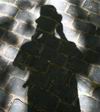Off the west coast of Scotland are some islands known as The Hebrides or The Western Isles. Some ancestors of mine came from The Isle of Harris, the outermost of the inhabited islands in The Hebrides, so I made a little pilgrimage there. It's an ancient land with a small population, rapidly shrinking - in numbers, not in height. As far as I know they are still as tall as they were 10 years ago, but they are 20% fewer. The land is inhospitable, not suited to modern farming, the weather is shockingly terrible, and conservation bodies block any attempt at creating new industries. I had a feeling of being at the edge of the world. When I mentioned this to a particularly intelligent local, he pointed out that in the days before cars, trains, and planes dominated transport, the region was often visited by ships on their way from Europe to North America, and in those days definitely wasn't at the ends of the earth.
As we arrived by ferry, I thought I was seeing the surface of the moon. Although it was stark and inhospitable, the scenery was quite captivating. The entire Harris part of the Isle is dominated by such rounded rocky outcrops, and was filmed by Stanley Kubrick as the surface of Jupiter in 2001: A Space Odyssey. As we drove through the island, I could see that the rocks hid many small lochs and waterfalls, and allowed small patches of grass and shrubs to grow, although barely a single tree. The road was shared with sheep, grazing where they could, who used the rocks to hide from the persistent gusty winds and sleeting rain. Surprisingly there are some beautiful, white, sandy beaches on the western side with excellent surf.
I found the place on the sea that according to locals was probably the small property where my great-grandfather lived. Unfortunately due to erosion over the years, the place is now not so much on the sea as it is under the sea. My dream of finding a seaside property that I could claim on behalf of my family was literally washed away.
The entire island was once owned and controlled by the "Macleod of Macleod" clan, and hence even today, people with the surname McLeods and Macleods make up a large part of the population. It was a bit odd travelling around a place where every fourth business and landmark had my name. Macleod Hotel, McLeods Transport, The Stone of Macleod, and the tomb of the Chieftan Alexander Macleod were just a few.
I had the chance to see some ancient stone circles and monoliths, of which the afore-mentioned Stone of Macleod was one. The island, and indeed much of Scotland has many of these Stonehenge-like structures. They consist of massive slabs of stone arranged in patterns based on the seasons, the sun, and the moon. These were mostly built about 4500 to 5000 years ago by ancient Celts, for reasons unknown although many theories exist. In one small patch of the neighbouring island there were 3 stone circles within 5 miles. The effort to build these in non-mechanical days would have been enormous, and it seems some were built over a period of several hundred years. The biggest mystery to me is this: 5000 years ago, when the earth's population was so small and there was so much space, why would people choose to live in such a cold and wet place instead of on the Mediterranean or in the Caribbean?
Another thought: People say that the world would be better without television, because then more people would be outside doing things. But consider the ancient Celts. They had no television, and all they could think to do was cart enormous slabs of stone around the countryside.
Lord Leverhulme, the man who owned the Unilever soap company which made him very rich, once bought the entire island, and had a number of crackpot schemes to stimulate the island's economy. All failed. One such scheme involved turning a town with practically no sea access into a ocean-going fishing industry. Another scheming person, from Germany, tried to launch the world's first rocket-delivered mail service in the area.
After visiting the island, I stayed a night in a castle in the Highlands, now used as a youth hostel. When the owner died in the mid 20th century, it was donated to the Scottish Youth Hostel Association. The halls are lined with statues and artwork donated with the castle, there are grand staircases, a watch-tower, and even a secret passage, opened by turning the base of a particular statue. I ate dinner in a pub 15 minutes walk away, reached by walking through the fields, down country lanes, and over a footbridge. The way back in the dark could have been hard, but the castle was illuminated on its hilltop, which as a beacon, is a pretty hard thing to miss.
Tuesday, September 16, 2003
Subscribe to:
Post Comments (Atom)

No comments:
Post a Comment